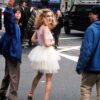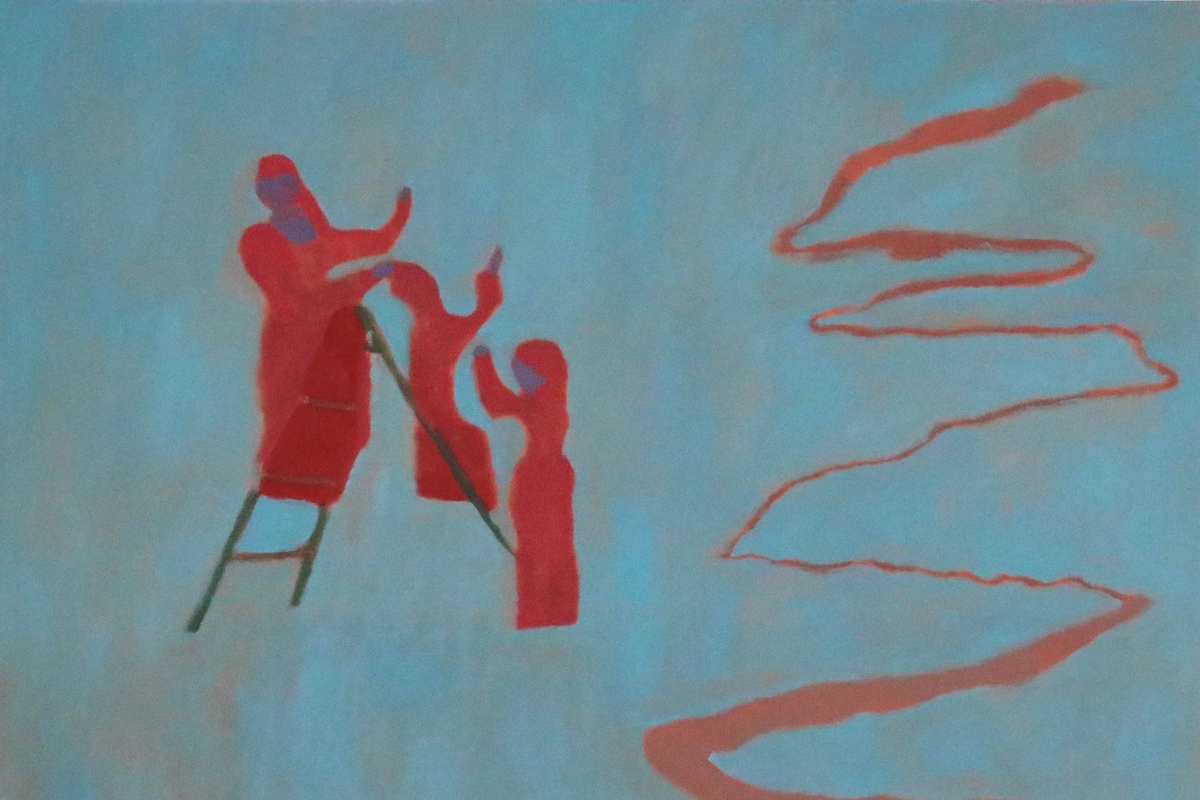
Rewrite
In the wake of its 18th edition, here are our favourite discoveries from the Middle East’s leading art fair
Last month marked the 18th edition of Art Dubai, located in the city’s picturesque Madinat Jumeirah resort – all palm trees and turtle-filled lagoons (not a white tent in sight). There, alongside a bustling programme of talks and special commissions, around 120 galleries from over 40 countries foregrounded some of their most exciting artists, with a particular focus on modern and contemporary art from the Middle East, North Africa and the Global South. Here are eight exciting discoveries from this year’s event, ranging from unexpected works by old favourites to emerging talent to watch out for.
At Ronchini’s stand, the spotlight was directed at Brazil-born, New York-based artist Paula Querido, courtesy of a dedicated, and no less dreamlike, solo presentation. Querido delivers a singular take on landscape painting, one that honours both the physical reality of our natural surroundings and the landscapes that exist only in our mind – a merging of mood, memory and imagination dictated by our internal states. This sense of surreality is sparked by her bold colour choices and soft-edged brushwork, which conjures figures engaged in various tasks (acrobatics, ladder clambering and more) against minimalist backdrops with which they are neither fully merged nor entirely separate from. The resulting works are both familiar and mysterious, igniting nostalgia and narrative intrigue by turns.
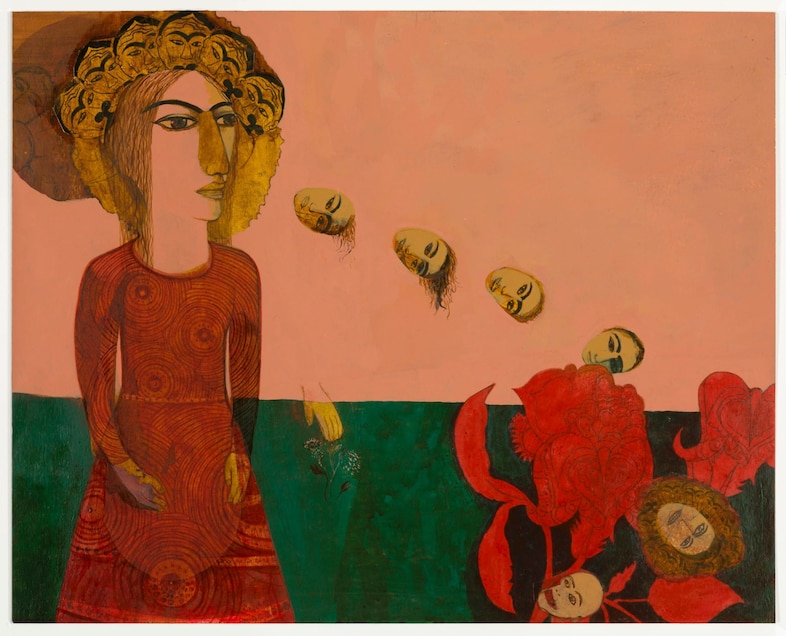
Samira Abbassy at Richard Saltoun Gallery
Following a stand-out show with Richard Saltoun in New York earlier this year – her first solo exhibition – Iranian-born, New York-based artist Samira Abbassy’s work made a notable appearance at the London gallery’s Art Dubai stand. Abbassy’s oneiric paintings and drawings explore the multi-layered physical and metaphysical elements of the self, conjuring something at once deeply personal and universal. Her intricate practice draws on a mixture of European and Iranian-Persian artistic traditions that reflect the complexities of diasporic identity – something she experienced first-hand growing up in London. She is also deeply interested in Jungian psychoanalysis, as embodied by her recurring use of mirrored figures – an allusion to Jung’s Ego versus Shadow model, demonstrated here in her 2021 piece The Soul is the Face You Had Before, with its captivating cascade of falling heads.
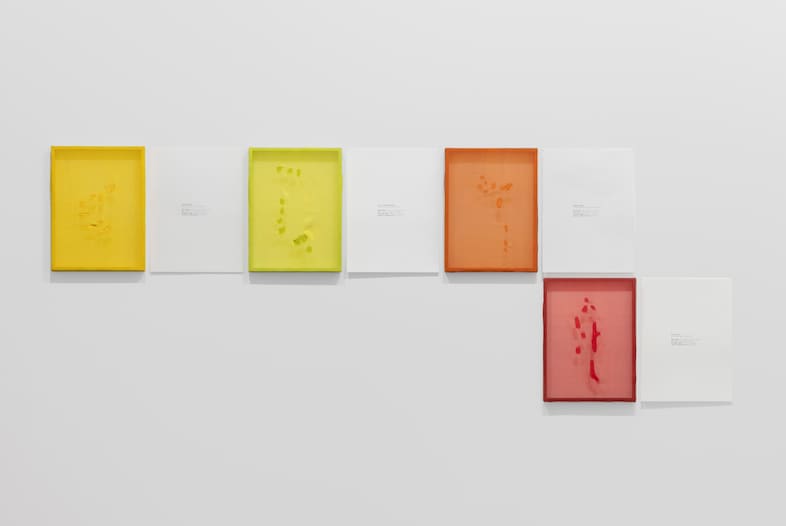
Dana Awartani at Sfeir-Semler Gallery
Palestinian-Saudi artist Dana Awartani’s latest work made a striking impression at Sfeir-Semler Gallery’s stand. Made from handcrafted silk fabrics – stretched on frames, and dyed with herbs and spices used in South Asian and Arab traditional medicine – the pieces are conceived to hang serially alongside corresponding typewritten texts. Closer inspection reveals that holes have been torn into the textiles, and thereafter hand-darned. “Awartani’s material choices speak to the work’s ethical and ecological terms of production,” the gallery explains. “The dual emphasis on artisanal production and indigenous medicinal knowledge … [represents] acts of resistance against mental and technological colonial violence.” The repaired punctures in the textiles, meanwhile, correspond to “the silhouettes of physical violence enacted on buildings in Arab nations at the hands of Islamic fundamentalists” – the specific details of which are listed in the accompanying texts. A powerful ode to, and evocation of, collective healing.

Adesola Yusuf at Gazell.io
In the significantly sized digital art section, one work in particular jumped out. At Gazell.io, Gazelli’s digital branch, Nigerian painter and digital artist Adesola Yusuf presented two on-screen collages, Do You Listen To LoFi? and Attension Seeker, both depicting snappily dressed figures framed by patterned tiles. Objects from daily life (an apple, a record player) as well as more elusive symbols (a human heart, a sword) serve as attributes of sorts, lending the protagonists a saint-like quality. Indeed, art historical references abound in Yusuf’s work, ranging from the High Renaissance to Pop Art, albeit with their own distinct edge. Fascinated by the possibilities of uniting tradition and technology, Yusuf describes his work as a “visual soliloquy” that uses “dynamic colours and layered compositions to explore personal narratives, sociopolitical themes, and the cultural landscape of Lagos.”

Andy Warhol at BMW
Did you know that Andy Warhol once painted a BMW? Well, he did, in 1979 – a BMW M1 racing car that raced at Le Mans the same year, finishing sixth. The tradition of artist-decorated BMW race cars began four years earlier, in 1975, when the French racing driver Hervé Poulain called upon Alexander Calder to paint a BMW 3.0 CSL. This year, to mark the 50th anniversary of the initiative – which continues to this day, with everyone from Julie Mehretu and Jenny Holzer to John Baldessari and Cao Fei having taken their turn at transforming a sports car into a moveable sculpture – BMW are showcasing all 20 Art Cars at different cultural institutions and events on all five continents. In Dubai, it was Warhol’s wonderfully adorned automobile that took centre stage: a chance to admire the hand-applied swathes of paint – six litres no less – up close. Warhol painted the entire vehicle in just 28 minutes, his frenetic, multicoloured vision an expressionistic meditation on speed itself. “I attempted to show speed as a visual image,” the artist said. “When an automobile is really travelling fast, all the lines and colours are transformed into a blur.”
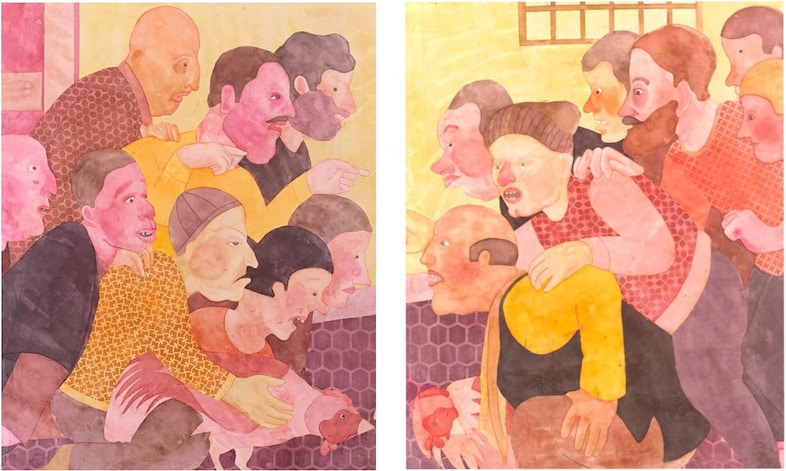
Orkideh Torabi at Sarai Gallery
Iran’s Sarai Gallery compiled a fantastic array of paintings by four Iranian artists on their roster – Morteza Khakshoor, Abbas Nasle Shamloo, Azin Zolfaghari and Orkideh Torabi. It was hard to choose a favourite, but two pendant paintings by the Tehran-born, New York-based artist Torabi, proved particularly enthralling. Carried out with dye on stretched cotton, these portray a cock fight in which the two feathered contestants appear far less combative than their respective gaggles of supporters, who scowl and sneer at one another, fingers pointing, teeth bared. These cartoonish, theatrically staged figures are typical of Torabi’s style, which fuses personal narrative and cultural heritage, drawing on Persian miniature painting techniques to challenge “traditional notions of femininity, power dynamics and identity”. Here, she casts a distinctly female gaze on a traditionally male-dominated pursuit, highlighting the displaced aggression such animal fights inspire.

Pascale Marthine Tayou at Galleria Continua
At Galleria Continua’s booth, the media-traversing talent of the acclaimed Cameroonian artist Pascale Marthine Tayou was on full display via a lively tapestry of sewn towels and one of Tayou’s Poupées Pascale (or Pascale’s Dolls), an ongoing series of hand-blown crystal figures embellished by fabric, wood, beads, rope and other such accoutrements of assemblage. The poupées are caricatures of humankind, their diverse symbolism and material hybridity a means of interrogating the cultural and societal influences that shape our identities in a globalised, postcolonial world. This notion is playfully elucidated here by the four painted figurines that flank the doll, each representative of a different profession. No matter which mode of expression Tayou embraces (from videos to sculptures to vast installations) or which theme he tackles (be it climate change or globalisation), he always does so with joy. As he once said, “If I want to talk about an injury, I’ll do so by talking about the cure, trying to bring a kind of comfort.”
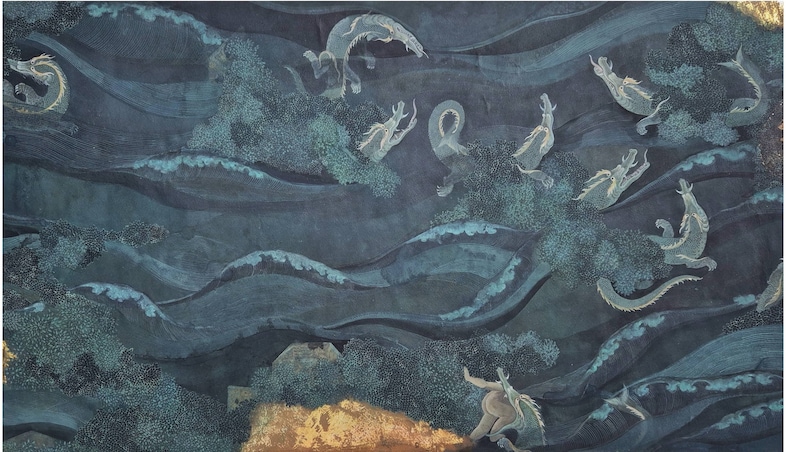
Anindita Bhattacharya at Gallery Threshold
Last year, Anindita Bhattacharya took up position as the Frere Hall artist-in-residence at Oxford’s Ashmolean museum, the first Indian artist to do so. And standing before her sprawling multi-panelled painting at Gallery Threshold’s stand, it’s evident that further recognition awaits. Bhattacharya’s extraordinarily intricate fine-brush painting style deliberately recalls “a language forged in the imperial Mughal courts of Delhi, Agra”, but her references extend much further, from medieval Gothic gargoyles to the Turkish monsters of Siyeh. While traditional techniques and storytelling inform her practice, however, the themes she explores are unerringly relevant. This piece depicts a swirling body of water, which, upon further scrutiny, is found to contain “monstrous forms and crocodilian figures” – one of whom is consuming a nude human figure whole. The discreet inclusion of these carnivorous creatures symbolises “nature’s relentless cycles of life and decay”, not always visible but ever-present.
Find out more about Art Dubai here. With special thanks to BMW.
in HTML format, including tags, to make it appealing and easy to read for Japanese-speaking readers aged 20 to 40 interested in fashion. Organize the content with appropriate headings and subheadings (h1, h2, h3, h4, h5, h6), translating all text, including headings, into Japanese. Retain any existing
tags from
In the wake of its 18th edition, here are our favourite discoveries from the Middle East’s leading art fair
Last month marked the 18th edition of Art Dubai, located in the city’s picturesque Madinat Jumeirah resort – all palm trees and turtle-filled lagoons (not a white tent in sight). There, alongside a bustling programme of talks and special commissions, around 120 galleries from over 40 countries foregrounded some of their most exciting artists, with a particular focus on modern and contemporary art from the Middle East, North Africa and the Global South. Here are eight exciting discoveries from this year’s event, ranging from unexpected works by old favourites to emerging talent to watch out for.
At Ronchini’s stand, the spotlight was directed at Brazil-born, New York-based artist Paula Querido, courtesy of a dedicated, and no less dreamlike, solo presentation. Querido delivers a singular take on landscape painting, one that honours both the physical reality of our natural surroundings and the landscapes that exist only in our mind – a merging of mood, memory and imagination dictated by our internal states. This sense of surreality is sparked by her bold colour choices and soft-edged brushwork, which conjures figures engaged in various tasks (acrobatics, ladder clambering and more) against minimalist backdrops with which they are neither fully merged nor entirely separate from. The resulting works are both familiar and mysterious, igniting nostalgia and narrative intrigue by turns.

Samira Abbassy at Richard Saltoun Gallery
Following a stand-out show with Richard Saltoun in New York earlier this year – her first solo exhibition – Iranian-born, New York-based artist Samira Abbassy’s work made a notable appearance at the London gallery’s Art Dubai stand. Abbassy’s oneiric paintings and drawings explore the multi-layered physical and metaphysical elements of the self, conjuring something at once deeply personal and universal. Her intricate practice draws on a mixture of European and Iranian-Persian artistic traditions that reflect the complexities of diasporic identity – something she experienced first-hand growing up in London. She is also deeply interested in Jungian psychoanalysis, as embodied by her recurring use of mirrored figures – an allusion to Jung’s Ego versus Shadow model, demonstrated here in her 2021 piece The Soul is the Face You Had Before, with its captivating cascade of falling heads.

Dana Awartani at Sfeir-Semler Gallery
Palestinian-Saudi artist Dana Awartani’s latest work made a striking impression at Sfeir-Semler Gallery’s stand. Made from handcrafted silk fabrics – stretched on frames, and dyed with herbs and spices used in South Asian and Arab traditional medicine – the pieces are conceived to hang serially alongside corresponding typewritten texts. Closer inspection reveals that holes have been torn into the textiles, and thereafter hand-darned. “Awartani’s material choices speak to the work’s ethical and ecological terms of production,” the gallery explains. “The dual emphasis on artisanal production and indigenous medicinal knowledge … [represents] acts of resistance against mental and technological colonial violence.” The repaired punctures in the textiles, meanwhile, correspond to “the silhouettes of physical violence enacted on buildings in Arab nations at the hands of Islamic fundamentalists” – the specific details of which are listed in the accompanying texts. A powerful ode to, and evocation of, collective healing.

Adesola Yusuf at Gazell.io
In the significantly sized digital art section, one work in particular jumped out. At Gazell.io, Gazelli’s digital branch, Nigerian painter and digital artist Adesola Yusuf presented two on-screen collages, Do You Listen To LoFi? and Attension Seeker, both depicting snappily dressed figures framed by patterned tiles. Objects from daily life (an apple, a record player) as well as more elusive symbols (a human heart, a sword) serve as attributes of sorts, lending the protagonists a saint-like quality. Indeed, art historical references abound in Yusuf’s work, ranging from the High Renaissance to Pop Art, albeit with their own distinct edge. Fascinated by the possibilities of uniting tradition and technology, Yusuf describes his work as a “visual soliloquy” that uses “dynamic colours and layered compositions to explore personal narratives, sociopolitical themes, and the cultural landscape of Lagos.”

Andy Warhol at BMW
Did you know that Andy Warhol once painted a BMW? Well, he did, in 1979 – a BMW M1 racing car that raced at Le Mans the same year, finishing sixth. The tradition of artist-decorated BMW race cars began four years earlier, in 1975, when the French racing driver Hervé Poulain called upon Alexander Calder to paint a BMW 3.0 CSL. This year, to mark the 50th anniversary of the initiative – which continues to this day, with everyone from Julie Mehretu and Jenny Holzer to John Baldessari and Cao Fei having taken their turn at transforming a sports car into a moveable sculpture – BMW are showcasing all 20 Art Cars at different cultural institutions and events on all five continents. In Dubai, it was Warhol’s wonderfully adorned automobile that took centre stage: a chance to admire the hand-applied swathes of paint – six litres no less – up close. Warhol painted the entire vehicle in just 28 minutes, his frenetic, multicoloured vision an expressionistic meditation on speed itself. “I attempted to show speed as a visual image,” the artist said. “When an automobile is really travelling fast, all the lines and colours are transformed into a blur.”

Orkideh Torabi at Sarai Gallery
Iran’s Sarai Gallery compiled a fantastic array of paintings by four Iranian artists on their roster – Morteza Khakshoor, Abbas Nasle Shamloo, Azin Zolfaghari and Orkideh Torabi. It was hard to choose a favourite, but two pendant paintings by the Tehran-born, New York-based artist Torabi, proved particularly enthralling. Carried out with dye on stretched cotton, these portray a cock fight in which the two feathered contestants appear far less combative than their respective gaggles of supporters, who scowl and sneer at one another, fingers pointing, teeth bared. These cartoonish, theatrically staged figures are typical of Torabi’s style, which fuses personal narrative and cultural heritage, drawing on Persian miniature painting techniques to challenge “traditional notions of femininity, power dynamics and identity”. Here, she casts a distinctly female gaze on a traditionally male-dominated pursuit, highlighting the displaced aggression such animal fights inspire.

Pascale Marthine Tayou at Galleria Continua
At Galleria Continua’s booth, the media-traversing talent of the acclaimed Cameroonian artist Pascale Marthine Tayou was on full display via a lively tapestry of sewn towels and one of Tayou’s Poupées Pascale (or Pascale’s Dolls), an ongoing series of hand-blown crystal figures embellished by fabric, wood, beads, rope and other such accoutrements of assemblage. The poupées are caricatures of humankind, their diverse symbolism and material hybridity a means of interrogating the cultural and societal influences that shape our identities in a globalised, postcolonial world. This notion is playfully elucidated here by the four painted figurines that flank the doll, each representative of a different profession. No matter which mode of expression Tayou embraces (from videos to sculptures to vast installations) or which theme he tackles (be it climate change or globalisation), he always does so with joy. As he once said, “If I want to talk about an injury, I’ll do so by talking about the cure, trying to bring a kind of comfort.”

Anindita Bhattacharya at Gallery Threshold
Last year, Anindita Bhattacharya took up position as the Frere Hall artist-in-residence at Oxford’s Ashmolean museum, the first Indian artist to do so. And standing before her sprawling multi-panelled painting at Gallery Threshold’s stand, it’s evident that further recognition awaits. Bhattacharya’s extraordinarily intricate fine-brush painting style deliberately recalls “a language forged in the imperial Mughal courts of Delhi, Agra”, but her references extend much further, from medieval Gothic gargoyles to the Turkish monsters of Siyeh. While traditional techniques and storytelling inform her practice, however, the themes she explores are unerringly relevant. This piece depicts a swirling body of water, which, upon further scrutiny, is found to contain “monstrous forms and crocodilian figures” – one of whom is consuming a nude human figure whole. The discreet inclusion of these carnivorous creatures symbolises “nature’s relentless cycles of life and decay”, not always visible but ever-present.
Find out more about Art Dubai here. With special thanks to BMW.
and integrate them seamlessly into the new content without adding new tags. Ensure the new content is fashion-related, written entirely in Japanese, and approximately 1500 words. Conclude with a “結論” section and a well-formatted “よくある質問” section. Avoid including an introduction or a note explaining the process.
